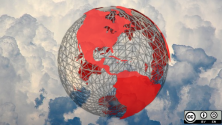Do the cultures of proprietary companies impede innovation? Do open source companies need a different sort of leadership? I've got my theories, but I don't have much to compare it to from my own experiences. I've been at Red Hat, a very open culture, for seven years and did a two-year tour at Alcatel before that. So I caught up with Cheryl McKinnon, Chief Marketing Officer at Nuxeo, an open source enterprise content management company, to explore open culture, leadership, and history.
 Cheryl is a very interesting person with a background as a historian and years of experience in enterprise content management. She can strike up a conversation about the role of women in technology, or she can spark a more intense debate about licensing issues with hosted subscription services.
Cheryl is a very interesting person with a background as a historian and years of experience in enterprise content management. She can strike up a conversation about the role of women in technology, or she can spark a more intense debate about licensing issues with hosted subscription services.
I wanted to get Cheryl's take on the differences between the proprietary and open source worlds from the leadership qualities to the innovative effectiveness of the culture:
What are the skills needed to be a leader at an open source company?
That's a great question, but I wonder if the qualities that make a good leader at an open source company are really any different than what's needed at any kind of technology company. Eric Barroca, Nuxeo CEO, and I have discussed this a few times, as I became immersed in the world of open source after more than a decade in the proprietary world. A software business needs to be driven by innovation and customer-centricity, regardless of the product licensing.
Agile is more than just the way we develop code–it's a state of mind. Good leadership does its homework and moves quickly to act once reasonable assumptions can be made. It's often better to do something as a test than stay in limbo. Small, iterative changes to our code, strategy, messaging, target markets are far better than waiting too long for all of the data points and missing the opportunity. Whether R&D or sales/marketing leadership–it is essential to test, measure, pay attention to feedback, and always find new places to tune and refine. Responsiveness to market conditions, customer requirements, competitive situations are all key to achieving an edge and staying on the front line. Does being an open source product company help us here? I think it does . . . because we rely on community feedback and input to keep us pushing ahead on technology innovation. Being open source might make it easier for us, but it's a quality all tech companies should strive for rather than sitting back in their comfort zone.
Let's talk culture. In your experience working at proprietary companies, what characteristics of their culture are holding back on innovation?
Honestly? I don't think being "proprietary" is necessarily what inhibits innovation. More often than not, it's those other attitudes to business that flourish in the proprietary world but are not necessarily uniquely due to the license model the company adopts. Top-down command and control hierarchies, siloed development teams, bigger interest in preserving high-margin maintenance revenues rather than reinvesting in newer platforms/features, pricing models that don't line up with what delivers value to the customer–these are the elements that inhibit innovation. While these inhibitors are far more prevalent in technology companies that are proprietary, it's not necessarily a direct cause and effect.
Let's flip sides. Which cultural attributes have you seen at open companies that are advancing innovation and opening the door for more opportunities?
My first observation was sheer joy at being with a company that walks the talk. The content management world has been enthralled by the world of Web 2.0 and social media for a couple of years now, and a lot of the right words about community, transparency, openness are thrown around, but not necessarily acted upon. It is refreshing to have customers who are seen as stakeholders in the technology not just because they pay annual maintenance and support, but because in some cases they've helped define the product or its roadmap. They've invested their time, efforts and contributions to community peer-to-peer support because they know they've benefited from it and have a stake in sharing information. It is incredibly refreshing to be able to point to key features in a new product release and know they've been put there because a customer invested the time and effort to contribute their work so the broader user base could benefit.
It is also a relief to dispense with much of the bureaucratic overhead of the typical license negotiation red tape that usually accompanies a sales cycle in a proprietary vendor. We engage our customers for maintenance and support packages as our revenue stream – but it is usually during the prototyping stage after the initial due diligence confirms the product offering is a good fit. Our Nuxeo Connect subscription services are tiered and tailored to make sure we benefit when our customer begin realize value from their content application development and deployment–not months beforehand by chasing license revenue. We don't put up a barrier between our prospects/customers and their ability to investigate how the product meets their needs. Customers know their business better than a software vendor, and their ability to do fascinating and creative things with our platform constantly amazes us. We don't want to stop this innovation.
What are some of the key components of the open source way found in knowledge management and how have you applied them throughout your career?
The last few years of my career have been spent exploring how organizations–private or public sector–can figure out the right balance between free flow of information/content with the necessary privacy and security issues dictated by their industry or jurisdiction. How can companies get the maximum benefit from collaboration and information sharing without risking breaching confidentiality issues regarding personnel matters, trade secrets, safety and security concerns. The entire Enterprise 2.0 movement over the last few years has sought to find this balance – openness and transparency within corporate-appropriate boundaries. “Knowledge Management” was a huge buzz word in the 1990s, becoming a bit tarnished in recent years as it became co-opted by vendors and top-down taxonomy driven programs. But the central goals still have incredible relevance–especially as we continue to rush into an increasingly digital information economy.
Established open source projects and communities are well-tuned knowledge sharing ecosystems–finding their own culture and communication channels to get real work done–pushing innovation while respecting previous past work. The knowledge capture and communication environments–whether mailing lists, discussion forums, wikis, etc. all show tangible and real examples of diverse and geographically diverse individuals working for common goals and purpose. If the "social marketplace" is that online engagement between vendor and customer collaborating for product improvement, then I argue that they are exhibiting those qualities that the 1990s KM movement and today's Enterprise 2.0 movement have championed.
We noticed you have some interest in history. What is the earliest application of the open source way you've come across in your studies?
Some interest in history is a good way to put it :-) . . . I've been professionally trained as an historian–not a developer. My PhD (though regrettably incomplete) dissertation was on the evolution of Access to Information/Freedom of Information laws in the mid-20th century, so the concept of openness and transparency has always been incredibly important to me. The ability for individual citizens to ask for and receive accurate and timely responses from their elected officials is essential to democracy and educated decision-making. Secrecy breeds bad behaviors and practices. One of my favorite quotes is from former U.S. Supreme Court justice Louis Brandeis, “sunlight is said to be the best of disinfectants.” If we believe in–and encourage–citizens or consumers or business decision makers, to be educated and aware, it means we encourage questions, inspection of data/code, fresh analysis of assumptions. If we as software vendors expect our customers to run mission-critical systems on our platforms, ensuring they have the ability to verify and validate its security and quality is an obvious advantage.
My passion for history and the preservation of human artifacts also plays into what I see as a critical coupling of open standards along with open source. Accessibility and preservation of content and data for the long term–decades or even centuries will be the massive challenge our online culture faces. As we move further away from physical media and printed artifacts, the need for long-term preservation of our digital legacy and footprint for future generations becomes essential. How ironic and tragic would it be that this age of information overload becomes the Dark Ages 2.0 when formats and device incompatibilities render the bits and bytes unreadable by tomorrow's historians.
To find out more:
- Visit Cheryl's blog: http://blogs.nuxeo.com/cmckinnon/
- Follow her on Twitter: @CherylMcKinnon






1 Comment